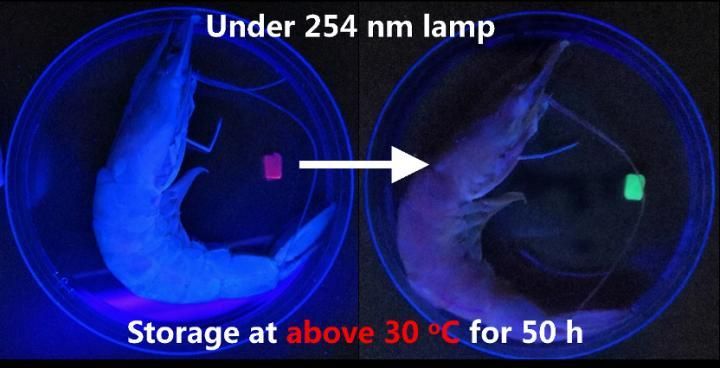Artificial color-changing material that mimics chameleon skin can detect seafood freshness
Scientists in China and Germany have designed an artificial color-changing material that mimics chameleon skin, with luminogens (molecules that make crystals glow) organized into different core and shell hydrogel layers instead of one uniform matrix. The findings, published May 6 in the journal Cell Reports Physical Science, demonstrate that a two-luminogen hydrogel chemosensor developed with this design can detect seafood freshness by changing color in response to amine vapors released by microbes as fish spoils. The material may also be used to advance the development of stretchable electronics, dynamic camouflaging robots, and anticounterfeiting technologies.

This image shows the color change of the "chameleon skin" hydrogel-based chemosensor in response to biogenic volatile amine vapors, which are a well known indicator of fish and shrimp spoilage.
Lu et al./Cell Reports Physical Science
"This novel core-shell layout does not require a careful choice of luminogen pairs, nor does it require an elaborate design and regulation of the complex photophysical interactions between different luminogens," says Tao Chen, a professor at the Ningbo Institute of Materials Technology and Engineering at the Chinese Academy of Sciences and an author of the study. "These advantages are important to the future construction of robust multicolor material systems with as-yet-unachieved performance."
While scientists have long envisioned developing soft materials that can fluctuate between a wide range of fluorescent colors with ease, synthetic materials are rarely able to change hue as artfully as chameleons do.
"Most artificial color-changing soft materials have been prepared by simultaneously incorporating two or more responsive luminogens into one single elastomer or hydrogel matrix," says Chen. "On the other hand, the organization of different iridophores into two superposed core-shell structured layers constitutes an evolutionary novelty for panther chameleons that allows their skins to display complex structural colors."
To determine whether artificial color-changing materials could be imbued with the natural core-shell structure of chameleon skin, Wei Lu, a researcher at the Ningbo Institute of Materials Technology and Engineering at the Chinese Academy of Sciences, and colleagues developed a multi-luminogen layered hydrogen system from the inside out. First, the researchers synthesized a red fluorescent core hydrogel, which would serve as a template for the other layers. This core hydrogel was incubated in various aqueous Europium solutions, after which the gel was incubated in a growth solution containing sodium alginate and responsive blue/green fluorescent polymers. Spontaneous diffusion of Europium ions from the core hydrogel into the surrounding solution triggered the formation of blue and green hydrogel layers.
Because of the way that the core and shell layers of the hydrogels overlapped, they could change from red to blue or green when triggered by changes in temperature or pH. The authors also note that the emission color of the blue and green fluorescent layers could be adjusted, enabling the material to display colors from nearly the full visible spectrum.
"The proposed diffusion-induced interfacial polymerization to prepare core-shell materials proves to be general," says Chen. "It is thus highly expected that the proposed synthetic strategy could be expanded to produce other soft color-changing materials, such as smart hydrogels or elastomers with stimuli-responsive structural color or pigment color change."
To test the abilities of a chemosensor crafted from a two-luminogen hydrogel to detect seafood freshness, Lu and colleagues sealed test strips made from the material in boxes with fresh shrimp or fish for 50 hours. The test strip stored with seafood at less than -10?C barely changed from its original red fluorescent color, indicating that the food was still fresh, while the test strip stored with seafood at 30?C shifted to a vivid green hue, indicating that the food had spoiled.
Chen suggests that both the novel core-shell hydrogels and the diffusion-induced interfacial polymerization strategy used to make them could prove useful in a diverse range of scientific fields, including robotics.
"In the near future, we plan to utilize the developed chameleon skin-like core-shell hydrogels to prepare biomimetic soft camouflaging skins, which can be used to mimic the diverse color-changing functions of living organisms' skins and to help achieve desirable active camouflage, display and alarm functions in robots," says Chen.




























































